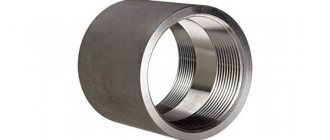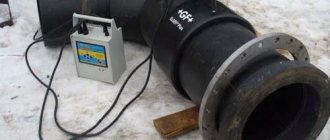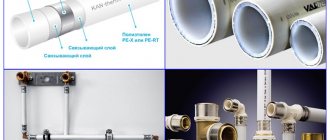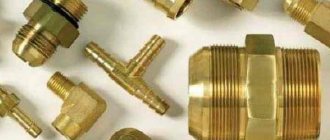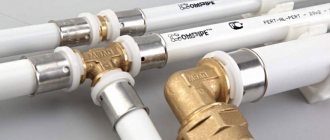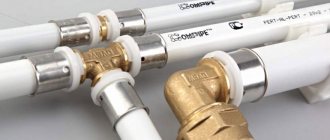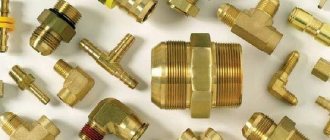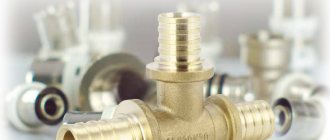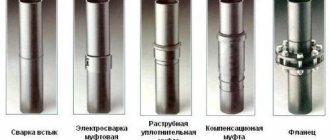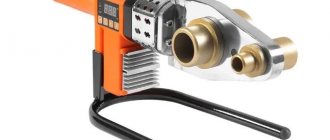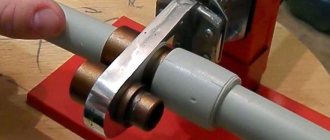- What is a fitting?
- Technical Specifications of Compression Fittings
- Features of HDPE compression fittings
- Arrangement of compression fittings
- Types of compression fittings
- Common sizes
- Connecting pipes using fittings - procedure
- Where are compression fittings used?
- Advantages and disadvantages of compression fittings
Laying pipe lines and other communications requires solving an important problem - connecting parts of pipes into a single system. You need to understand: no matter how long the segments are, there simply cannot be an endless pipe. And the second point is that any highway has turns and branches. Therefore, all communication consists of parts of HDPE pipes connected to each other by welding or through special parts - compression fittings.
The use of the latter greatly simplifies and speeds up the installation process, since it does not require the use of special equipment and large labor costs. To work successfully, you need to know what compression fittings are, what their features are, their types, and how to use them.
What is a fitting?
A fitting is a type of connecting elements (most often collapsible) for pipeline installation. With the help of these parts, sections of pipes of the same and different sections are joined, branched nodes and tie-ins are created, parts of the pipeline made of different materials are connected, and the final sections of communications are plugged.
Depending on the pipe material, fittings have characteristics that allow the use of connecting elements only for a certain type of pipeline. In modern construction, several types of fittings are used: threaded, welded, flanged, compression. The latter elements occupy a large place in the production of connecting mounting parts, as they allow pipes to be connected without welding.
Compression fittings are used to connect polymer pipes, including PE-80, PE-100. Another name for these parts is crimp, this is due to the peculiarity of their fastening using a crimp ring, which firmly secures the connecting element to the pipe.
Tips for choosing
First, you should draw a diagram of the future water supply or heating system, think over the location of all fittings, decide on the material for the pipes and then decide on the type of fittings, and calculate the quantity. In practice, more aesthetically pleasing cross-linked polyethylene pipes and metal fittings are used in kitchens and bathrooms; when laying underground and basement communications - HDPE and couplings made from it.
Such fittings are sold almost everywhere. It is better to buy in large stores, but such structures cannot be made in the garage, and factory-made products are also usually sold on the market. It is easier to exchange defects in stores.
Technical Specifications of Compression Fittings
Compression fittings for PE pipes are made from polypropylene copolymer, a durable innovative material, by casting. This material is inert to any chemical environment, which makes the connecting parts universal in use. By design, fittings as mounting elements are prefabricated and are supplied for sale completely ready for installation.
The diameters of compression fittings for HDPE pipes range from 16 to 110 mm. These connecting elements are capable of withstanding pressure from 10 to 16 atmospheres: at a temperature of 20⁰C for a pipe with a diameter of up to 63 mm it will withstand a pressure of 16, at higher rates - no higher than 10 Bar. Compared to HDPE pipes, fittings can withstand temperatures higher - up to 100⁰C, as they are made of more heat-resistant material.
A new generation of plastic material allows you to create elements of various configurations and purposes. These parts are available with internal and external threads. No special conditions are required for storage: polypropylene copolymer is not afraid of aggressive environments, including UV radiation.
High-quality fittings for PE pipes must have safety and quality certificates that guarantee the possibility of their use for organizing water supply communications.
You can read more about fittings in our other article “Fittings for HDPE pipes - types and purpose”
What are the permissible deviations in the dimensions of polyethylene pipes?
GOST 32415 standards provide for maximum permitted deviations from the required diameter and ovality parameters for pressure pipes.
| D, x1000 mm | Add. deviation >x10-1, mm | Ovality, mm x10-2ne > |
| 0,025 | 3 | 120 |
| 0,032 | 3 | 130 |
| 0,040 | 4 | 140 |
| 0,050 | 4 | 140 |
| 0,063 | 4 | 150 |
| 0,075 | 5 | 160 |
| 0,090 | 6 | 180 |
| 0,110 | 7 | 220 |
| 0,125 | 8 | 250 |
| 0,140 | 9 | 280 |
| 0,160 | 10 | 320 |
| 0,180 | 11 | 360 |
| 0,200 | 12 | 400 |
| 0,225 | 14 | 450 |
| 0,280 | 17 | 980 |
| 0,315 | 19 | 1110 |
| 0,355 | 22 | 1250 |
| 0,400 | 24 | 1400 |
| 0,500 | 30 | 1750 |
| 0,560 | 34 | 1960 |
| 0,630 | 38 | 2210 |
| 0,710 | 64 | — |
| 0,800 | 72 | — |
| 0,900 | 81 | — |
| 1,000 | 90 | — |
| 1,200 | 108 | — |
Table of maximum permitted deviations according to GOST 32415
Note!
According to the standards of GOST 18599 2001, pressure pipes made of polyethylene with a diameter of over 180 mm are manufactured and supplied in the form of sections up to 25 m long. Products with a smaller diameter can be supplied in coils.
Features of HDPE compression fittings
The main feature of compression fittings is their ease of installation. To connect pipes using these elements, no special equipment or professional knowledge is required. This quality is especially valuable when constructing temporary communication systems: after termination of operation, the connection can be easily disassembled.
To connect pipes of the same diameter, straight fittings are used; to connect sections of different parameters, transition or reducing parts are used. Thus, the use of such products allows you to increase the length of communication. Installation can be carried out in any weather conditions, including sub-zero temperatures. And the amount of assembly and disassembly of connecting elements will not affect their performance characteristics in any way.
Important!
The word “transitional” when designating a fitting can be interpreted in another way: experts call this a part equipped with a thread on one side and intended for a welded connection on the other. Such fittings are used to connect sections of PE pipes with metal ones.
Benefits of use
Users report many benefits of compression fittings. Thanks to their design, the connecting elements are suitable for the installation of cold and hot water supply pipelines made of polypropylene and low-density polyethylene grades PE80 and PE100.
Basically, they are used to install a cold water supply system based on an underground source in a private house, cottage or country house.
Gardeners and summer residents prefer compression fittings when constructing temporary water supply systems for watering their gardens. In both cases, compression connections show their best side:
- Easy to install without any prior preparation in just a few seconds.
- They do not require special engineering education and can be installed by a contractor without experience working with pipelines.
- Connections can be reused multiple times. The fittings can be installed and unscrewed up to 10 times without losing the tightness and strength of the connection, which significantly saves the user’s money.
- Corrosion resistance, resistance to rust and other destructive factors (ultraviolet, high temperature, air).
- Resistant to aggressive chemicals.
- Versatile for use in technical pipelines, as well as in drinking water supply systems.
The material used for making compression fittings is safe for humans, because... does not contain toxic compounds. When heated, it does not emit harmful components and can even come into contact with drinking water.
Important! Despite their versatility, plastic compression fittings have limitations on water supply pressure. They can be used within a working water pressure of up to 16 atmospheres.
Arrangement of compression fittings
Structurally, compression fittings are similar to each other. Connecting elements for HDPE pipes have the following device.
- Housing
equipped with external thread and lock. Made from polypropylene copolymer. The retainer limits the depth to which the pipe is inserted into the fitting. The trapezoidal thread prevents spontaneous unwinding when water hammer and vibrations occur in the pipeline. - Sealing ring
. Placed at the joint, it is made of nitrile rubber, which ensures reliability and tightness of the areas where the fitting is connected to the pipes. - Clamping ring
, collet. Prevents mechanical damage to the connection. The raw material for the ring is polyacetate, a material stronger than polyethylene. As a result, the collet, wrapping around the pipe around the circumference, additionally fixes the joint area, protecting it from loosening when the load increases and reliably holding the rubber O-ring in place. - Thrust sleeve
, designed to strengthen and hold the clamp ring in place. When pressure increases, it prevents damage to communications. - Two union nuts
made in the form of covers. Made from polypropylene copolymer (PPRC), designed to cover the joint.
The main material for the manufacture of compression fittings is polypropylene copolymer (PPRC), which has high strength and a degree of protection from ultraviolet radiation. This property, design features, reliability and ease of use of parts make them very popular when installing pipelines.
How they work
The design of couplings, angles and tees for connecting HDPE and cross-linked polyethylene pipes is similar.
Structurally, a compression compression fitting for transition from plastic to metal consists of an outer compression nut, rubber sealing collars, a thrust ring, a collet - a threaded body. All other types of couplings, bends, tees are made using this design.
Plastic couplings and tees are fundamentally designed similarly to steel products, but outwardly they are much more bulky and less aesthetically pleasing.
Types of compression fittings
Types of compression fittings vary depending on their purpose. The most common models of connecting crimp parts are as follows.
- Couplings
. Used to fasten pipes of the same or different diameters. Straight elements are used for one-dimensional fastening, reduction elements are used for connecting segments of different diameters. Couplings, often referred to as “repair connectors,” are the most popular installation parts: if a communication is damaged, it is enough to remove the failed part of the pipe, replace it with a new one, and reconnect the sections with a coupling, quickly and at no extra cost. - Bends
. These elements are installed at those pipe joints where it is necessary to change the direction of communication. - Tees
(or crosses). They are used where it is necessary to create branches: to divide the pipe flow into several. The most common elements are for installing pipe bends of smaller diameter - for example, to connect a consumer to a central main line. - Saddle bends
(or saddles). The part is used when inserting into a branch pipe. By their design, they are a type of cross with additional functions, a reinforced tee. - Stubs
. Used to quickly and firmly block communications. - HDPE flange compression connections
. A transitional type of fittings used to connect PE pipes of small diameters with metal communications, as well as HDPE products with various shut-off and control pipeline valves with a flange type of connection.
Fittings for various purposes and configurations are designed to simplify the installation and repair of pipelines for the common consumer. When performing the work, time for installation is gained and financial costs are reduced.
Species and types
First of all, compression connectors for plastic systems differ in the connection material: polyethylene for HDPE pipes, brass or nickel-plated steel for cross-linked polyethylene pipes.
Fittings are divided into:
- by design: straight, angular (bends), tees, plugs;
- by functions performed: connecting; transitional between plastic and steel pipes, shut-off valves or measuring instruments; transitions between pipes of different diameters.
Common sizes
The modern market offers a wide selection of models and sizes of compression fittings for HDPE pipes. To ensure the tightness of the connection, it is necessary to clearly know the diameter of the PE pipes and compare it with the parameters of the connecting elements. The most common fitting sizes are presented in this table. Dimensions are in mm and inches.
| Coupling with external thread | Transitional coupling | 90 degree bend | Coupling with internal thread | HDPE tee with internal thread | Male Tee | Saddle with threaded outlet |
| 32.0x1.1/4″ | 110×90 | 110×110 | 110×4″ | 63×2″63 | 63×2″63 | 63×1/2″ |
| 32,0×1″ | 90×75 | 90×90 | 63×2″x63 | 50×1 1/2″x50 | 50×1 1/2″x50 | 50×1″ |
| 32,0×3/4″ | 75×63 | 75×75 | 1/2″x50 50×1″ | 40×1 1/4″x40 | 40×1 1/4″x40 | 50×1/2″ |
| 25,0×1″ | 63×50 | 63×63 | 32×1″x32 | 32.0×1″x32 | 32×3/4″x32 | 40×1″ |
| 25,0×3/4″ | 50×40 | 50×50 | 25×1″25 | 32×3/4″x32 | 25×1″x25 | 40×1/2″ |
| 25,0×1/2″ | 40×32 | 40×40 | 25×1/2″x25 | 25×1″x25 | 25.0×1/2″x25 | 32×1″ |
| 20,0×3/4″ | 32×25 | 32×32 | 20×3/4″x20 | 25x.0x1/2″x25 | 20,0×3/4×20 | 32×1/2″ |
| 20,0×1/2″ | 25×20 | 20×20 | 20×1/2″x20 | 20.0×1/2″x20 | 20.0×1/2″x20 | 25×1/2″ |
Attention!
To eliminate the possibility of inconsistencies between pipeline elements, it is recommended to purchase connecting elements from the same manufacturer for installation.
You can learn more about fitting sizes here
.
PE pipes with increased heat resistance
Polyethylene pipes with increased heat resistance (PE-RT) are used in communications for hot and drinking water supply, low-temperature (up to 80⁰C) water heating, soil heating, and underfloor heating systems. Octene branches extending from the polymer main chain, which distinguish PE-RT from conventional PE, contribute to increased heat resistance, reliability and strength of the material. Such pipelines can operate under pressure from 2 to 10 bar at temperatures up to emergency 95⁰C.
The range of PE-RT pipes is presented in the table.
| SRO | 6 | 7,4 | 9 | 11 | 13,6 | 17 |
| D x102mm | Wall thickness x10-2, in mm | |||||
| 0,10 | 170 | 140 | 130 | 130 | 130 | 130 |
| 0,12 | 200 | 180 | 140 | 130 | 130 | 130 |
| 0,16 | 270 | 220 | 180 | 150 | 130 | 130 |
| 0,20 | 340 | 280 | 230 | 190 | 150 | 130 |
| 0,25 | 420 | 350 | 280 | 230 | 190 | 150 |
| 0,32 | 540 | 440 | 360 | 290 | 240 | 190 |
| 0,40 | 670 | 550 | 450 | 370 | 300 | 240 |
| 0,50 | 830 | 690 | 560 | 460 | 370 | 300 |
| 0,63 | 1050 | 860 | 710 | 580 | 470 | 380 |
| 1,25 | 2080 | 1710 | 1400 | 1140 | 920 | 740 |
| 1,40 | 2330 | 1920 | 1570 | 1270 | 1030 | 830 |
| 1,60 | 2660 | 2190 | 1790 | 1460 | 1180 | 950 |
| 1,80 | 2990 | 2460 | 2000 | 1640 | 1330 | 1070 |
| 2,00 | 3320 | 2740 | 2240 | 1820 | 1470 | 1190 |
| 2,25 | 3740 | 3080 | 2520 | 2050 | 1660 | 1340 |
| 2,50 | 4150 | 3420 | 2790 | 2270 | 1840 | 1480 |
| 3,15 | 5230 | 4310 | 3520 | 2860 | 2320 | 1870 |
| 3,55 | 5900 | 4850 | 3970 | 3220 | 2610 | 2110 |
| 4,50 | — | 6150 | 5030 | 4090 | 3310 | 2670 |
| 5,00 | — | 6830 | 5580 | 4540 | 3680 | 2970 |
PE-RT pipe assortment table
Attention!
You can learn more about the sizes and characteristics of PE pipes with increased heat resistance, as well as buy them, in the subsection Pipes for hot water supply.
PE-RT pipes are supplied in coils, coils, and sections. The deviation of pipes up to 12 m long is +-10 mm. Some acceptable deviations and ovality of products are presented in the table.
| D, x100 mm | Deviations > mm | Permissible ovality, not >, x10-1mm |
| 0,20 | 0,3 | 12 |
| 0,25 | 0,3 | 12 |
| 0,32 | 0,3 | 13 |
| 0,50 | 0,5 | 14 |
| 0,90 | 0,9 | 18 |
| 1,10 | 1,0 | 22 |
| 1,25 | 1,2 | 25 |
| 1,80 | 1,7 | 36 |
| 2,00 | 1,8 | 40 |
| 2,25 | 2,1 | 45 |
| 2,50 | 2,3 | 50 |
| 2,80 | 2,5 | 98 |
| 3,15 | 2,8 | 111 |
| 4,00 | 3,6 | 140 |
| 4,50 | 3,8 | 158 |
| 7,10 | 4,9 | — |
Table of permissible deviations and ovality of PE-RT products
This type of polyethylene was approved and included in the standards GOST R 52134 (as amended in 2010), and in September 2015 - in the latest edition of GOST 32415–2013.
Note!
PE-RT is polyethylene with increased heat resistance, meeting the requirements of GOST 52134, GOST 32415–2013 and other standards, today it is the best solution for municipal heating systems and hot water supply.
Where are compression fittings used?
The versatility of compression fittings, ease of installation and use have led to their use in various fields of activity:
- public water supply;
- when repairing damaged pipes;
- organization of water supply systems for industrial purposes;
- arrangement of greenhouses;
- laying water pipes in low-rise buildings;
- organization of irrigation systems;
- sewerage systems.
Compression fittings can be assembled and disassembled many times; if the fastener fails, you don’t necessarily have to buy a new one: you can get by by replacing the worn part.
Connecting pipes using fittings - procedure
The procedure for connecting HDPE pipes using fittings is as follows.
- Pipe preparation: cleaning from dirt, cutting to the desired size at an angle of 90⁰C.
- Cleaning joints from burrs, debris, rounding edges. The pipe should not have any irregularities or defects.
- Dismantling the fitting, installing the blue nut on the pipe, installing the white clamping ring so that its thick section is directed towards the tail of the pipe.
- The fitting is inserted into the pipe until it stops, and the clamping ring is inserted into the gap.
- Tighten the blue nut - first by hand until it stops, then use a chain wrench if necessary.
Installation of a HDPE pipeline using fittings is simple, but has its own characteristics, so when carrying out work it is necessary to rely on factory instructions and recommendations of specialists.
